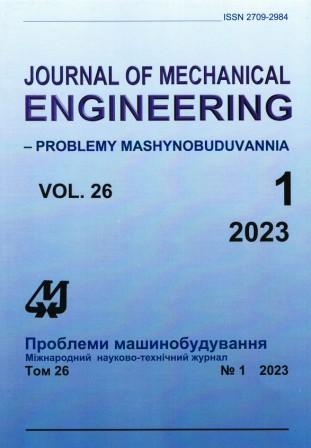Simulation of the Erosion-Corrosion Destruction Process of Steam Turbine Low-Pressure Cylinder Blades
Abstract
This paper is devoted to the important problem of creating a method for predicting the intensity of erosion-corrosion destruction of the working blades material of low-pressure stages of powerful steam turbines, considering the complex physical processes that accompany the emergence, transformation of erosion-hazardous droplets and their interaction with elements of the flow path. The features of the construction of some existing erosion models are considered. The model that is developed at the Institute of Mechanical Engineering Problems of the National Academy of Sciences of Ukraine and based on a deterministic-statistical approach to its creation is analyzed in detail. The calculations performed during the research showed a satisfactory coincidence with the results of experimental tests by various authors, obtained on droplet impact stands, which contributed to the successful use of the model in creating a comprehensive method of predicting the wear of working blades. To do this, it was supplemented by the method of determining the parameters of the erosive environment based on the droplet movement equation, taking into account the size distribution law. Along with that, it is shown that the considered model, although it allows to carry out fairly accurate prediction of the development of erosive wear at the modern level, has difficulties in its construction due to the need to identify it from the data of full-scale experiments, the number of which is limited. It has been established that one of the important reasons for the discrepancies that arise is the failure to include of the electrophysical component of the processes occurring in a two-phase flow. In this regard, the results of comprehensive studies of steam electrization and its influence on the working processes of wet steam turbines are considered. It is shown that the change in the properties of the working medium as a functional erosive medium as a result of electrification causes a significant increase (relative to neutral wet steam) of electrochemical processes. At the same time, the kinetics of the damage accumulation to the metal surface layer changes due to the joint occurrence of several negative processes: droplet impact influence; electrochemical processes caused by mechanical and structural and chemical heterogeneity of the surface; hydrogen absorption; changes in mechanical properties under the electric field influence. It was noted that the contribution of hydrogen absorption to changes in mechanical properties is the greatest. According to a preliminary assessment, the complex negative droplet impact and electrophysical influence on the metal surface reduces the incubation period and intensifies the erosion-corrosion process by approximately 2 times
Downloads
Published
Issue
Section
License
Copyright (c) 2023 О. Л. Шубенко, А. О. Тарелін

This work is licensed under a Creative Commons Attribution-NoDerivatives 4.0 International License.
All authors agree with the following conditions:
- The authors reserve the right to claim authorship of their work and transfer to the journal the right of first publication of the work under the license agreement (the agreement).
- Authors have a right to conclude independently additional agreement on non-exclusive spreading the work in the form in which it was published by the jpurnal (for example, to place the work in institution repository or to publish as a part of a monograph), providing a link to the first publication of the work in this journal.
- Journal policy allows authors to place the manuscript in the Internet (for example, in the institution repository or on a personal web sites) both before its submission to the editorial board and during its editorial processing, as this ensures the productive scientific discussion and impact positively on the efficiency and dynamics of citation of published work (see The Effect of Open Access).

